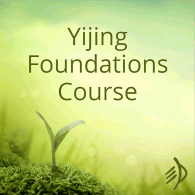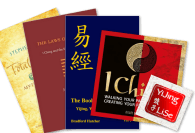There are two lines in Hexagram 27, Nourishment, that refer to ‘rejecting the standard’:
‘Unbalanced nourishment.
Hexagram 27, line 2
Rejecting the standard, looking to the hill-top for nourishment.
Setting out to bring order – pitfall.’
‘Rejecting the standard,
Hexagram 27, line 5
Dwelling here with constancy: good fortune.
Cannot cross the great river.’
So what are ‘standards’, and what does it mean to reject them, and where does it leave you when you do?
Warp threads
The word I’ve translated as ‘standards’ is jing 經 – which is one half of the name of the oracle, Yijing / I Ching . There, it means ‘Classic book’ – an honorific for works of supreme importance, also used for the Bible and the Sutras. You can see how this derives from the earliest meaning of the word, warp threads: the long, strong threads on the loom, through which all the colours of the pattern are woven. The jing form the basic framework for our culture and understanding; they hold everything else together.
The same word also means the meridians for blood and qi in Chinese medicine, lines of longitude, menses, putting virtue into practice, imitating the ancestors, and – above all – the constant rules. Jing is whatever remains in place and is always applicable.
I wanted to describe all these meanings to emphasise how radical it would be to reject the standards. This is not just a matter of being a bit unconventional, showing up barefoot to a posh restaurant or some such. The whole culture is saying, ‘This is how it always has been and always must be,’ and you’re sweeping that aside.
(‘Rejecting’, 拂 fu, means to brush off, as in brushing off dust, as well as going against or defying. It seems both rebellious and also dismissive. In 27.3 one rejects not the standards, but nourishment itself, which is an unmixedly Bad Idea.)
27 line 2 – unbalanced nourishment
‘Unbalanced nourishment.
Rejecting the standard, looking to the hill-top for nourishment.
Setting out to bring order – pitfall.’
Almost all translations and interpretations agree that this one is wrong to reject the standard. Wilhelm (/Baynes) translates firmly as ‘deviating from the path’; Deng Ming Dao says ‘you disobey the right ways,’ and so on. The idea (from line theory) is that line 2 looks to be nourished by the yang line 6, which is too far away – that it is more or less begging for food rather than earning its living. Deng Ming Dao thinks the line should ‘find nourishment in the nearby hills instead of journeying far away,’ while some also say it’s wrong to lean on the yang line 1. Bradford Hatcher describes it as alternating between valley and summit, in the spirit of ‘the grass is always greener on the other side of the fence’, and getting nowhere. But despite differences, almost all commentators are agreed that line 2 is getting it all wrong.
The exceptions I’m aware of are Karcher – who says ‘Clearing the channels, rejecting the rules’ and is sure this is what you should be doing – and LiSe:
6 at 2: Wholly intent jaws, Rejecting the regular path to the hill. For jaws to set things right: pitfall
Hexagram 27 line 2, LiSe Heyboer’s translation and commentary
Do not try to restrain what is by nature excessive. Changing a Tao causes accidents. In the world all is about the normal, but the world lives by what is abnormal. So give the excessive enough room to exist.
Compare that with Bradford:
Subverted appetites
Hexagram 27 line 2, Bradford Hatcher’s translation
Dismissing the customary,
Going into the hills hungering
Going boldly into failure
Bradford uses the (beautiful!) balance of his sentence to imply that this is all describing one thing: going into the hills hungering means going boldly into failure. But I find I’m more persuaded by LiSe: ‘bringing order’, originally a punitive military expedition to put down unrest and restore harmony – and by extension in readings, the effort to fix the situation and set everything to rights – is the opposite of rejecting the standard.
In practice, in readings, the message seems simpler: you can’t sort this out and make it work, neither by restoring the old standard nor by overwriting it. This is just not a good time for fixing things. I’ve found that people described by this line tend to be moved by some unmanageable hunger that can’t be immediately satisfied. It may show up as idealistic, unfeasible aspirations; it may be misplaced – onto shiny new consumer goods, for instance – but then neither buying the thing nor conquering the desire will quite resolve it. Maybe the best you can do for now is to stay hungry.
In trigram terms, this is inner thunder becoming/revealing inner lake: the inner spark of energy and initiative looking to open and connect, energetically seeking exchange and enrichment.
In hexagram terms, this is 27 changing to 41: Nourishment’s Decreasing. That’s true in the plainest sense: then this one rejects nourishment through regular channels with nothing within reach to replace it, it will certainly end up with less. But it may also be that you need to follow the direction of Hexagram 41 and make the offering, leave the vessel empty and the space open, not try to fill it.
27 line 5 – dwelling with constancy
‘Rejecting the standard,
Hexagram 27, line 5
Dwelling here with constancy: good fortune.
Cannot cross the great river.’
Traditional commentary is a little easier on line 5 than line 2. This one is obliged to depart from the norm, according to which it should be providing for those below, because as a yin line it lacks the means to do so. Instead it calls on line 6 for help, and should have no major undertakings of its own:
‘It is not permitted to undertake any mission that involves overcoming great difficulties, or significantly influencing the future, as one still relies on others to accomplish one’s duty.’
Tuck Chang on 27.5
So perhaps it’s necessary to find an unconventional route, here, in order to do what’s required of you.
Bradford sees this one as experimenting with diet, rather than driven hither and yon by appetites as at line 2; LiSe sees someone ‘taking the road less travelled’. And in practice, this does seem to describe people who have reasons for rejecting the conventional ways of nourishment – who need to make a change. (There are a couple of I Ching Community examples where this line describes someone incapable of receiving nourishment through a relationship, perhaps because they’re not yet in a position to give.) What they need is to ‘dwell here with constancy’ – to hold still and establish a stable base. They’re not capable of crossing rivers, taking the plunge and forging ahead into new lands: the resources just aren’t available. (And if ‘standards’ call for such commitment, too bad.)
The trigram picture here is of mountain and wind/wood: stillness, ‘dwelling here with constancy’, with a view to steady, organic growth. And the hexagram picture is of Nourishment’s Increasing: Hexagram 27 changing to 42. Hence the sense of positive aspirations behind this rejection – ‘aspiring to a richer and broader flow,’ as I put it in my book. And if you check the fan yao – the ‘reverse line’, 42.5 changing to 27 – you can see that the ultimate need and motivation might indeed be to have more to give –
‘True and confident, with a benevolent heart,
Hexagram 42, line 5
No question: good fortune from the source.
Truth, confidence and benevolence are my own strength.’
Learning from the connected hexagrams
There are always lessons to be learned from the relationships between hexagrams. Hexagram 27 ‘rejects the standard’ – the jing, the constant laws that always apply, the underlying structure that makes everything else make sense – just at the points where it intersects with Hexagrams 41 and 42, Decreasing and Increasing. These two encapsulate the whole cycle of loss and gain, and with it something of a paradox –
‘Decreasing, Increasing: the beginnings of abundance and decline.’
The Zagua (contrasting hexagrams)
Gain comes through loss, loss comes through gain. To be filled up, you must first empty your vessel – have, or be, less. You will need to ‘restrain desires’ (according to the Image of 41) and be immensely flexible, always available for improvement (according to the Image of 42).
Hexagram 27 in this context brings a big transition – a kind of major surgery, an inner rewiring or replumbing where your whole digestive and circulatory system gets rewritten. And while this is going on, you will be in a kind of limbo, a blank space between sources of nourishment. You might be asked for commitment, or feel the need to restore balance, but you’re in no position to start ‘bringing order’ or wading rivers; you barely know where you are, let alone where to go.
About not crossing rivers…
‘Rejecting the standard,
27.5
Dwelling here with constancy: good fortune.
Cannot cross the great river.’
and yet
‘Increasing, fruitful to have a direction to go.
Hexagram 42, the Oracle
Fruitful to cross the great river.’
And likewise, if line 2 changes as well, the relating hexagram will be 61, Inner Truth:
‘Inner truth. Piglets and fishes, good fortune.
Hexagram 61, the Oracle
Fruitful to cross the great river.
Constancy bears fruit.’
So what are we to make of this ‘contradiction’ – can we cross that river, or not?
This all makes sense as soon as you consider the differing roles of different parts of the reading. These relating hexagrams describe an underlying purpose: to join the flow of decrease and increase, or to be centred in Inner Truth: a larger-scale, longer-term river crossing is underway. Or to look at it another way, Inner Truth is your only guide to rejecting and rewriting the jing, the external standards – and it promises ‘piglets and fishes’, both nourishment and the means to participate in the flow through offerings.
But as you look towards Increase, or to Inner Truth (and yes, this is one occasion when it does make sense to imagine the relating hexagram in the future!), the rules of nourishment will have to be rewritten. And this all begins with a rejection of what works, which will more or less incapacitate you for a while.
Another way to understand this: between the caterpillar and the butterfly, pupation:
As this article puts it, ‘first the caterpillar digests itself‘. The chrysalis doesn’t go anywhere, but the insect is transformed, changing its standard of nourishment from leaves to nectar.











